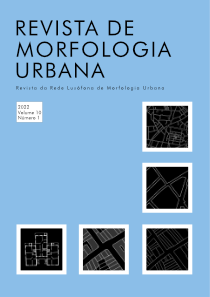Resumo
Apresenta-se um diagrama abrangente da epistemologia do campo da morfologia urbana como um primeiro passo para ilustrar as conexões possíveis entre diferentes escolas de pensamento. O estudo dos métodos de geração de conhecimento neste campo mostra que muitas práticas conceituais e metodológicas são compartilhadas. Esta epistemologia compartilhada pode se tornar uma base para a comparação de tipos de teorias e conhecimento gerados por diferentes escolas de pensamento. Foram considerados os métodos usados, as bases para o julgamento de sua validade e o escopo de suas questões. Foi proposta uma definição sistemática dos elementos que os morfologistas usam para sua interpretação.
Referências
Akbar, J. A. (1988) Crisis in the built environment: the case of the Muslim city (Concept Media, Leiden).
Bafna, S. (2003) Space syntax: a brief introduction to its logic and analytical techniques, Environmental and Behavior 35, 17-29.
Bosselmann, P. (2008) Urban transformation: understanding city design and form (Island Press, Washington, DC).
Caniggia, G. e Maffei, G.L. (2001) Architectural composition and building typology: interpreting basic building (Alinea Editrice, Firenze).
Coehlo, C. D. e Forma Urbis Lab (2014) A methodology for the analytical interpretation of the urban fabric, artigo não publicado apresentado no Twenty-First International Seminar on Urban Form, Porto, julho.
Conzen, M. P. (2009) How cities internalize their former urban fringes: a cross-cultural comparison, Urban Morphology 13, 29-54.
Conzen, M. P. (2013) Substance, method and meaning in urban morphology, Urban Morphology 17, 132-4.
Conzen, M.R.G. (1960) Alnwick, Northumberland: a study in town-plan analysis, Institute of British Geographers Publication 27 (George Philip, London)
Conzen, M. R. G. (2004) Thinking about urban form: papers on urban morphology, 1932-1998 (Peter Lang, Oxford).
Firley, E. e Stahl, C. (2009) The urban housing handbook (Wiley, Chichester).
Gauthier, P. e Gilliland, J. (2006) Mapping urban morphology: a classification scheme for interpreting contributions to the study of urban form,Urban Morphology, v. 10, n. 1, p. 41-50.
Hiller, B. e Hanson, J. (1984) The social logic of space(Cambridge University Press, Cambridge).
Jacobs, A. B. (1993) Great Streets (MIT Press, Cambridge, MA).
Koter, M. (1990) The morphological Evolution of a nineteenth-century city center: Lodz, Poland, 1825-1973, in Slater, T. R. (ed.) The built form of Western cities: essays for M. R. G. Conzen (Leicester University Press, Leicester) 109-41.
Kropf, K. (2001) Conceptions of change in the built environment, Urban Morphology vol. 5 no. 1 pp. 29-42.
Kropf, K. (2009) Aspects of urban form, Urban Morphology 13, 105-20.
Kropf, K. (2011) Morphological investigations: cutting into the substance of urban form, Built Environment 37, 393-408.
Kropf, K. (2013) Evolution and urban form: staking out the ground for a more mature theory, Urban Morphology 17, 136-49.
Kropf, K. (2014) Ambiguity in the definition of urban form, Urban Morphology 18, 41-57.
Kropf, K. e Malfroy, S. (2013) What is urban morphology supposed to be about: specialization and the growth of a discipline, Urban Morphology 17, 128-31.
Larkham, P.J. (2006) The study of urban form in Great Britain. Urban Morphology 10, 117–141.
Lynch, K. (1981) Theory of good city form (MIT Press, Cambridge, MA).
Margolis, H. (1987) Patterns, thinking and cognition (University of Chicago Press, Chicago).
Marshall, S. (2005) Streets and patterns: the structure of urban geometry (Spon, London).
Marzot, N. (2002) The study of urban form in Italy, Urban Morphology 6, 59-73.
Moudon, A. V. (1992) A catholic approach to organizing what urban designers should know, Journal of Planning Literature 6, 331-49.
Moudon, A. V. (1997) Urban Morphology as an Emerging Interdisciplinary Field,Urban Morphology, 1, 3-10.
Moudon, A. V. e Hubner, M. H. (2000) Monitoring land supply with Geographic Information Systems: theory, practice, and parcel-based approaches (Wiley, New York).
Oliveira, V., Monteiro, C. e Partanen, J. (2015) A comparative study of urban form, Urban Morphology 19, 73-92.
Panerai, P., Castex, J., Depaule, J.-C., and Samuels, I. (2004) Urban Forms: The death and life of the urban block (Architectural Press, Oxford).
Pinho, P. and Oliveira, V. (2009) Different approaches in the study of urban form, Journal of Urbanism 2, 103-25.
Rowe, C. e Koetter, F. (1978) Collage city (MIT Press, Cambridge, MA).
Scheer, B. C. (2001) The anatomy of sprawl, Places 14(2) 28-37.
Scheer, B. C. (2010) The evolution of urban form: typology for planners and architects (American Planning Association, Chicago, IL).
Stanilov, K. (2010) Bridging the gap between urban morphology and urban modelling, Urban Morphology 14, 123-4.
Steadman, P. (1979) The Evolution of designs: biological analogy in architecture and the applied arts (Cambridge University Press, Cambridge).
Todorovic, D. (2008) Gestalt principles, Scholarpedia 3, 5345 (http://www.scholarpedia.org/article/Gestalt_principles) acessado em 21 de julho 2015.
Turri, J. (2014) Epistemology: a guide (Wiley, London).
Whitehand, J.W.R. (2001) British urban morphology: the Conzenian tradition, Urban Morphology 5, 103-9.
Whitehand, J. W. R., Gu, K., Conzen, M. P. e Whitehand, S. M. (204) The typological process and the morphological period: a cross-cultural assessment, Environment and Planning B: Planning and Design 41, 512-33.

Este trabalho está licenciado sob uma licença Creative Commons Attribution 4.0 International License.
Copyright (c) 2022 Brenda Case Scheer; Karin Schwabe Meneguetti


